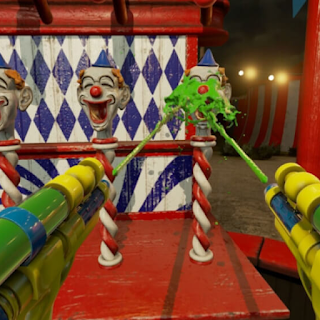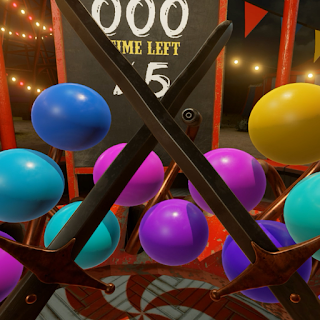If you have been reading my blog, you'll know that my opinion of the VR software market is that you have to pay a lot for not much at the moment. As a result I'm still very much tied to looking at the free or low cost games and experiences you can play.
Actually, I'm spending most of my time in Fallout 3 using VorpX. It's really great fun, slightly tarnished by the instability of the game, but fast and easy quicksaving means you only need a bit of patience for that.
So on the side I'm still trying other things out, and I recently discovered that the nVidia VR Funhouse is free on Steam. So here is a review!
What is it?
nVidia VR Funhouse serves 2 purposes
- It is 9 funfair style mini games of varying types.
- It is a tech demo of nVidia VR graphics
The Games
The games are based on either a throwing, shooting or hitting mechanic.
 |
| Clown Painter |
- Clown Painter - You have to shoot paint into the mouths of clown heads in order to pop the overhead balloons. The guns have a paint cartridge that only recharges when not being used, so part of the game is managing your 2 guns so you are not wasting time.
- Fire Archer - Basic shoot the target game, but the flame arrows means it doesn't matter where you hit the target, score is based on target difficulty.
- Balloon Knight - You are in a circle where balloons starting inflating from around you and you have to pop them with the 2 swords you have. Slashing the balloons doesn't work because the sides of the sword are dull, you have to pop them with the tip, which adds to the challenge.
- Basketball - Standard fairground game to get as many balls in the hoop as you can.
- Wallwalker - You have to fling jelly octupuses (octupi?) at a target and make sure they permanently stick in order to keep your score.
- Whack-a-Mole - Standard fairground whack-a-mole with 5 targets.
- Mole Boxing - The same moles return. They spring towards you and you have to punch them back.
- Shooting Gallery - Shoot all the pottery in the allotted time.
- Cannon Skeet - Similar to shooting gallery except this time the pottery is being fired up in the air by a moving cannon.
 |
| Whack-a-mole |
And that sums up one of the things I like about these mini games, to get the best score possible, you are thinking about the physics in orders to get the best score, whether it is throwing the octupus using a certain technique or trying to find the easiest way to throw the basketballs.
The other thing I like is you can think outside the box a bit and cheat to gain a small advantage. For example, with the basketball game, the balls are halfway up the machine on a platform that only retracts when the timer starts, but actually you can lean forward and grab a ball in each hand before the timer starts to get that extra second for the best score.
 |
| Balloon Knight |
Well... I think testing is a mundane job, and I work in IT.😛
As a Tech Demo
nVidia VR Funhouse is actually quite a cool tech demo as well. The graphics as far as the general environment go are to a good standard, but the real point of the demo are the special effects. Flame effects, water stream and splat effects, very high particle confetti and the general physics. All the effects are very convincing and cool. The confetti in particular is something that might pass you by unless you take a second to stop and admire it, literally 100s or 1000s of confetti particles around you, all with their own depth relative to you, spinning and blustering around, and all being individually rendered very smoothly, it's actually quite impressive.
 |
| Cannon Skeet |
Have patience, however, because actually, if you give the game 30-60 seconds to settle down, it goes back to being a very smooth VR experience, even on my GTX 970. It seems the game just needs some time to finish loading itself up when it first starts and then it is basically fine. It's a bit odd, really, because you'd expect a company like nVidia to do better than creating such a poor initial experience, but nonetheless, patience is well rewarded. Maybe this issue is only because I have a less than minimum spec GTX 970 for this game, I'd be interested in knowing how other peoples' experience are.
To Summarise
Well it's free, so the price is right. The graphics are good, the games are good fun. There's the issues with the game being choppy right after startup but really it is no big deal.
nVidia VR Funhouse is one of those games where you think this would make a great party game with a few friends round. Trouble is, of course, you only have the one headset.
My final point, if you are a hard working career person and don't get nearly enough exercise (I'm giving away my secrets) then you'd do well to play this game just because actually it will warm you up when you are waving your swords around or whacking or punching moles! Play it once a day, spend 5 minutes getting your blood flowing (or do some proper exercise instead).
I highly recommend nVidia VR Funhouse. Free and good clean fun for all the family.


















